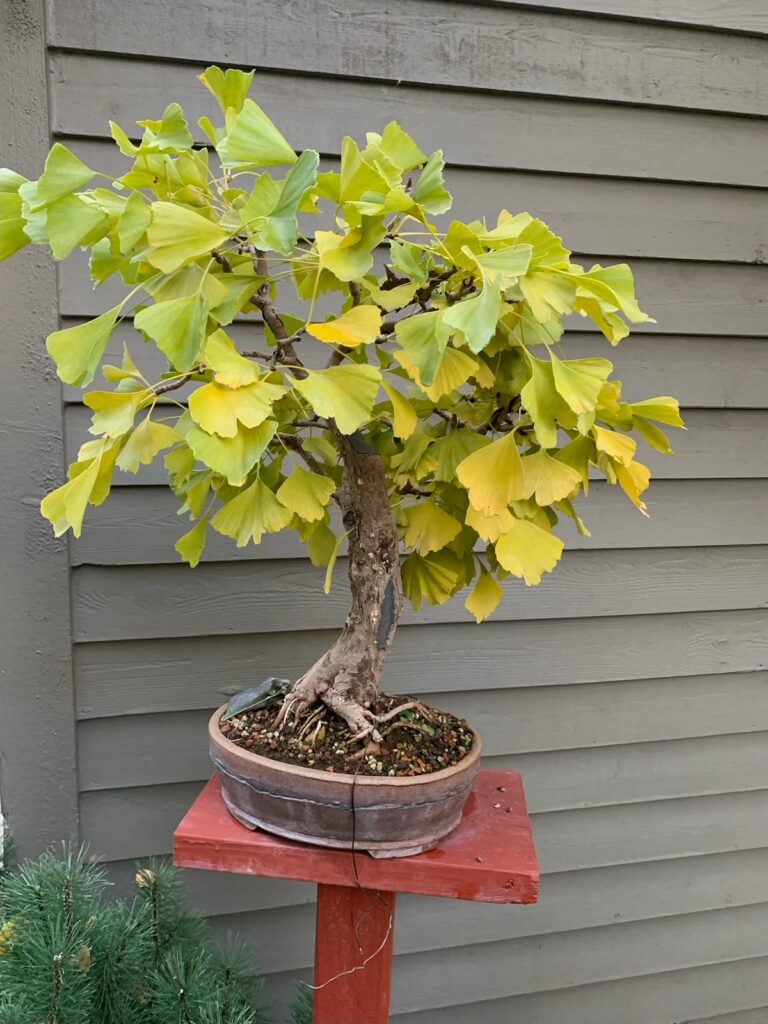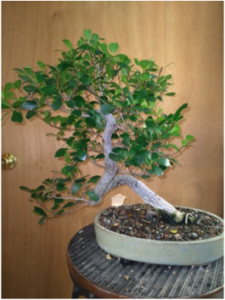
The ginkgo is a deciduous tree with fan shaped leaves and a columnar silhouette in younger years, getting broader with age. The tree is indigenous to China and is considered a living fossil, dating back 270 million years.
On young trees the bark is light grey and on old trees dark grey and furrowed. Some old trees produce so-called „Chichi“, hanging swellings reminding of stalactites. The largest and oldest ginkgo trees are found in China, some of them are more than 40 m (130ft) tall and approximately 4,000 years old. The ginkgo is dioecious, which means there are male and female trees. The ripe fruits of the female ginkgos have a very unpleasant smell. Ginkgo bonsai hardly ever bear fruit, so this is not of much importance. The seeds are edible and popular in East Asia. The leaves of the ginkgo turn brightly yellow in autumn, before they fall. Ginkgos are robust, can grow in diverse soils and places and tolerate pollution. For these characteristics they are often planted along busy streets in big cities. Six famous ginko trees have even survived the atomic bomb in Hiroshima in 1945, only 2 km from the the center of the explosion. Extracts from gingko seeds and leaves are used for medical purposes.
These trees are capable of sprouting along cliff banks and other rocky surfaces. Unlike some bonsai trees that are coniferous, the Ginkgo biloba is actually a leafy tree. In fact, it was the lobed leaves of the tree that gave it its alternative name—the Madenhair tree, after the Madenhair fern that has similar leaves.
Place the ginkgo outside all year round. It prefers a sunny position but young trees are better placed in semi-shade. The ginkgo can endure frost but when it is planted in a bonsai pot the rootball should be protected from very low temperatures.
New long shoots should be shortened to one or two leaves when five or six have grown. Ginkgo trees can be wired at any time of the year. The branches are quite flexible. Take care not to damage the soft bark of the branches and twigs with the wire. Pruning should only be done in either the spring or the fall; to prune Ginkgo bonsai trees, clip away leaf clusters to reduce the clusters to just two or three leaves, always keeping the top leaf on the outside.
The best shape for a Ginkgo bonsai tree is its natural shape, but its leaf clusters allow for it to be pruned into a decent broom-like shape if desired. If a Ginkgo bonsai tree requires wiring to maintain its desired shape, then only a very thin, delicate wire should be used since these trees have such fragile bark.
Younger trees can be repotted every year in spring, older ones every two to five years. Don’t prune the roots too heavily. A standard soil mix is fine, but it must be well-draining.
The ginkgo tree can be propagated from seeds and cuttings. Air-layering is also possible. The seeds have a hard shell and should be stratified or scarified before they are planted. It can take two years until they germinate.
The ginkgo is very resistant and is hardly ever attacked by insects or fungal diseases.
Fertilising the gingko biloba bonsai is important to encourage growth. A balanced, liquid fertiliser should be applied every fortnight during the growing season (spring and summer).
The Ginkgo Biloba tree, one of the world’s oldest and most primitive living organisms, can be found in more than one place on the planet. It is thought to have evolved from conifers some 200 million years ago, and it has remained relatively unchanged. The tree is thought to have lived for up to 1000 years, and its average lifespan is around 500 years. With proper care, a ginkgo bonsai can live for many years and will become a cherished part of your home.



